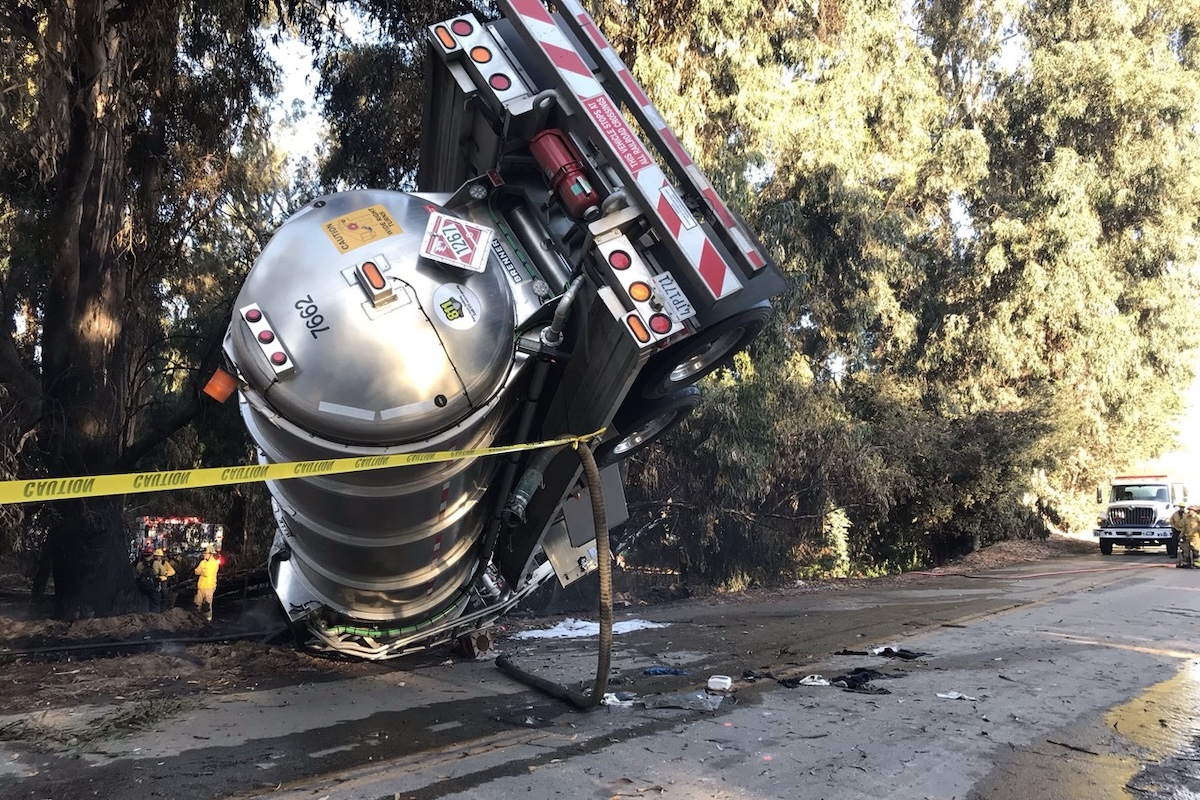Oil-Trucking Proposal Hits Bump in Road at Santa Barbara County Planning Commission
SBCAN Appeals Sentinel Peak Resources’ Permit to Construct Truck Loading Facility Near Lompoc

Plans to truck crude oil 165 miles from Santa Barbara County to Fresno are hitting a bump in the road due to crash-and-spill concerns.
In April, the county’s Planning Department approved a permit for Sentinel Peak Resources to construct a truck loading facility at its Purisima Hills oil plant near Lompoc. This “truck rack” would allow the company to transport an average of six tanker loads (i.e., around 40,320 gallons of crude) daily to Coalinga for up to 50 years. Advocacy groups say the proposal reeks of the region’s sticky history with oil.
For now, the century-old Lompoc Oil Field sits idle. It stopped producing oil in January 2023 when its only method of getting oil to market — the Phillips 66 Line 300 pipeline — was shut down. And it will remain idle until a shipping option becomes available.
Sentinel wants to revive oil production by installing the truck rack. However, the Santa Barbara County Action Network (SBCAN) is appealing Sentinel’s permit to the County Planning Commission to prevent those trucks from ever hitting state roadways.
During the commission’s Wednesday hearing, SBCAN Co-Executive Director Ken Hough explained that the crux of the appeal is that the number of trucks, the distance of the route, and the lifespan of the project puts it “in the same order of magnitude as the ExxonMobil trucking proposal, which your commission and the board [of supervisors] denied.”

Oil giant ExxonMobil’s trucking proposal died earlier this year after being shot down by county officials, mainly over spill concerns. It would have allowed the company to restart offshore oil production and truck millions of gallons of oil per week on Highway 101 and Route 166.
Hough went through a recent history of denials, withdrawals, and bankruptcies by other oil companies in the region, including ExxonMobil, and argued that the environmental hazards for the Sentinel project would be the same. The truck route would cross through six state highways, a county road, and a city street, posing similar risks to public safety, as well as emitting more than 999 tons of greenhouse gasses per year and “flying in the face of” the county’s Climate Action Plan, he said.
However, commissioners failed to see eye to eye with Hough on the project’s magnitude, saying that ExxonMobil’s trucking project was of a much larger scope — with 70-80 trucks per day — and also involved “enhanced production methods,” such as fracking or steam injection that heats the oil. Sentinel’s production does not include those same methods, and rather relies on gravity, which Commissioner Roy Reed called “one of the cleanest methods of oil production.”
Trucking would be limited to 2,000 trips per year to keep greenhouse gas emissions under the 1,000 metric ton threshold set by the county, with quarterly trucking reports to keep Sentinel in compliance.
And, with only five or six round trips a day, “Would it really make a difference in the number of oil trucks passing through these areas?” Reed asked.
The commissioners did, however, agree with SBCAN that the 50-year timeframe of the permit was lengthy and shared concerns over the “worst-case scenario” — a traffic accident could cause a truck to spill oil into surrounding areas.
Still, County Planning staff recommended the denial of SBCAN’s appeal on the grounds that the project “would not result in any significant and unavoidable impacts” to the environment and traffic, according to the project’s Draft Mitigated Negative Declaration (MND).
The size of the project and its assessed risks, the county determined, was “not anywhere near the county’s threshold” for a more rigorous environmental review, said Supervising Planner Errin Briggs. Any public health risks of exporting crude oil via trucks, he said, would be less severe than those associated with historic pipeline operations.
With the proposed mitigation measures in place, the probability and potential severity of an accident is low enough, Briggs explained. One of those measures includes a restriction on trucking during rainy days, when a half inch of rain or more is predicted in 24 hours, to prevent any potential spillage from entering waterways.
Briggs said the project’s annual probability of an oil spill (more than five gallons) from trucking operations is one in 239 years (i.e., not likely to occur during the project’s lifetime).
For Commissioner Michael Cooney, however, “probably won’t happen” was not good enough, and relying on predictions for rainy day restrictions without clear monitoring protocol seemed “squishy.”

“Annual probability doesn’t mean there won’t be accidents [and] doesn’t mean there won’t be problems that we look back on and say, ‘Gosh, did we approve this, really?’” Cooney mused. “So I’m not really comforted by the annual probability as a number.”
To reassure the commissioners and the public, Sentinel’s Environmental Health and Safety Manager David Budy said the company is “committed to compliance and protecting the health and safety of our workers, community, and environment.”
Budy reminded the commission that the company has paid $3 million in property tax revenue to the county since it took over the Lompoc Oil and Gas Plant in 2017. He said they “don’t want to operate a truck loading rack for 50 years” — the company’s proposed timeline based on how long the field may still be fruitful— as they would like to see the revival of a pipeline system instead. He also said that they are contracting an award-winning trucking company, Gazelle, recognized for its safe reputation, as well as using newer trucks and trained drivers, under a comprehensive trucking plan that includes protection measures and spill notification procedures.
Additionally, he pointed out that in the route they chose — after evaluating multiple routes — only 31 miles pass through Santa Barbara County. None of those miles, Briggs mentioned, are near any of the county’s “environmental justice communities.”
However, some of the commissioners emphasized that all affected communities in and outside county lines should be involved and notified in the process. Briggs said that the cities of Lompoc, Santa Maria, and other jurisdictions were given notice and provided with the plans for review but did not comment. He noted that it’s possible the other counties along the route — e.g., San Luis Obispo and King County — may not be aware of the proposal, but that they already have a lot of oil tanker traffic so “it would be nothing new for them.”
Public commenters brought up concerns such as this public and environmental impact across county lines, concerns around pollution, and the not-so-uncommon possibility of an oil-trucking accident. In 2023, the Federal Motor Carrier Safety Administration (FMCSA) reported 12,753 such accidents in California, with the majority happening in the daytime and in congested areas of Los Angeles County.
Sentinel’s Budy stated that if it were a condition of approval, the company would be open to shortening the permit timeline to 25-30 years and only trucking during off-peak hours.
No decision was made, though. At the risk of opening the “giant can of worms that comes with an extended hearing process,” in the words of Commissioner Reed, the commission continued the hearing to October 30 to field more information on traffic, timelines, and potential impacts.
Premier Events
Sun, Dec 22
11:00 AM
Santa Barbara
Mosaic Makers Market – Holiday Market Finale
Wed, Dec 25
6:00 PM
Santa Barbara
FREE Contra Dance X-mas Day💃Corwin & Grace band6-9
Sun, Dec 22
11:00 AM
Santa Barbara
Mosaic Makers Market – Holiday Market Finale
Sun, Dec 22
2:00 PM
Santa Barbara
Santa Paws Holiday Party – A Howliday Celebration
Tue, Dec 24
2:00 PM
Santa Barbara
Brass Bear Christmas Eve Buffet
Tue, Dec 24
5:00 PM
Santa Barbara
Christmas Eve at the USSB
Wed, Dec 25
5:30 PM
Santa Barbara
Christmas Dinner at El Encanto
Fri, Dec 27
6:00 PM
Solvang
New Year Disco Ball Paint & Sip
Fri, Dec 27
9:00 PM
Santa Barbara
Film Screening: “Indiana Jones and The Last Crusade”
Sat, Dec 28
7:00 PM
Lompoc
Rosie Flores & Grey DeLisle + Special Guests LIVE
Sat, Dec 28
7:00 PM
Carpinteria
Family Comedy Night at The Alcazar
Sat, Dec 28
7:00 PM
Santa Barbara
The Temptations at Casa De La Raza
Sun, Dec 22 11:00 AM
Santa Barbara
Mosaic Makers Market – Holiday Market Finale
Wed, Dec 25 6:00 PM
Santa Barbara
FREE Contra Dance X-mas Day💃Corwin & Grace band6-9
Sun, Dec 22 11:00 AM
Santa Barbara
Mosaic Makers Market – Holiday Market Finale
Sun, Dec 22 2:00 PM
Santa Barbara
Santa Paws Holiday Party – A Howliday Celebration
Tue, Dec 24 2:00 PM
Santa Barbara
Brass Bear Christmas Eve Buffet
Tue, Dec 24 5:00 PM
Santa Barbara
Christmas Eve at the USSB
Wed, Dec 25 5:30 PM
Santa Barbara
Christmas Dinner at El Encanto
Fri, Dec 27 6:00 PM
Solvang
New Year Disco Ball Paint & Sip
Fri, Dec 27 9:00 PM
Santa Barbara
Film Screening: “Indiana Jones and The Last Crusade”
Sat, Dec 28 7:00 PM
Lompoc
Rosie Flores & Grey DeLisle + Special Guests LIVE
Sat, Dec 28 7:00 PM
Carpinteria
Family Comedy Night at The Alcazar
Sat, Dec 28 7:00 PM
Santa Barbara
























You must be logged in to post a comment.